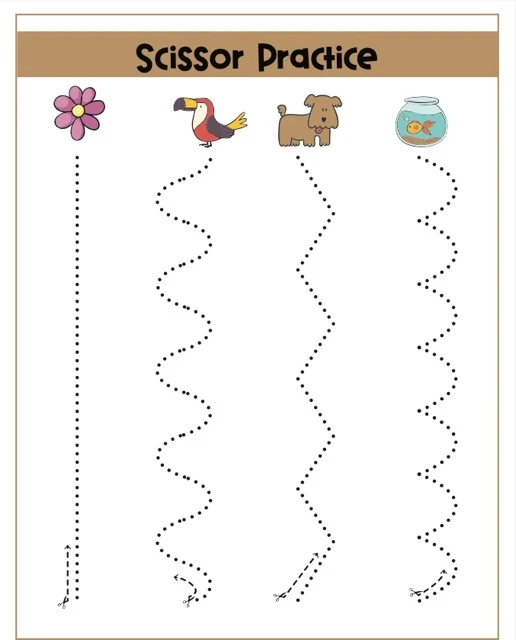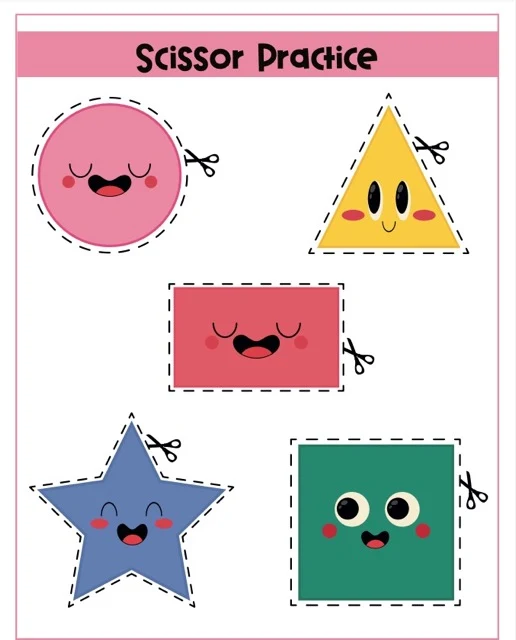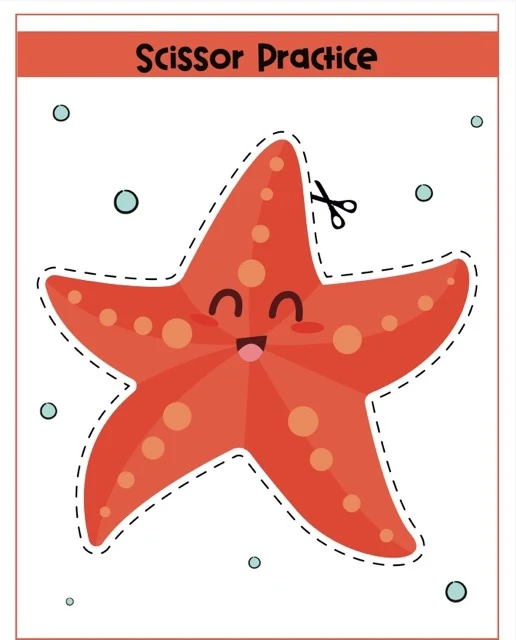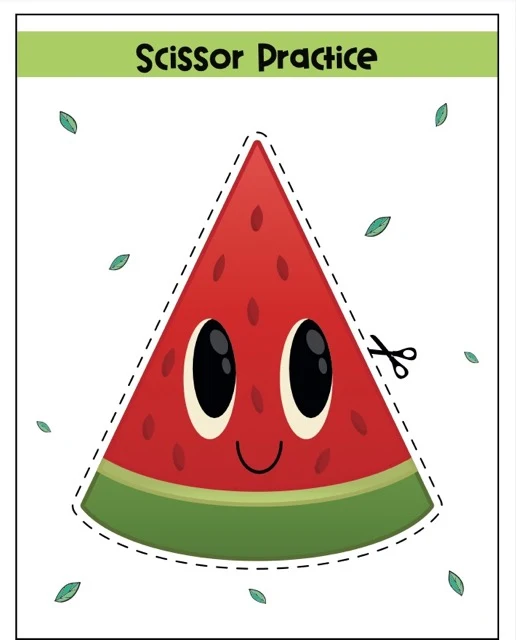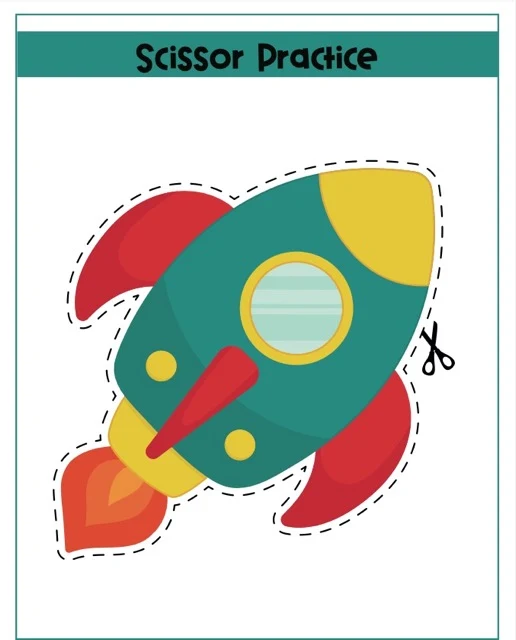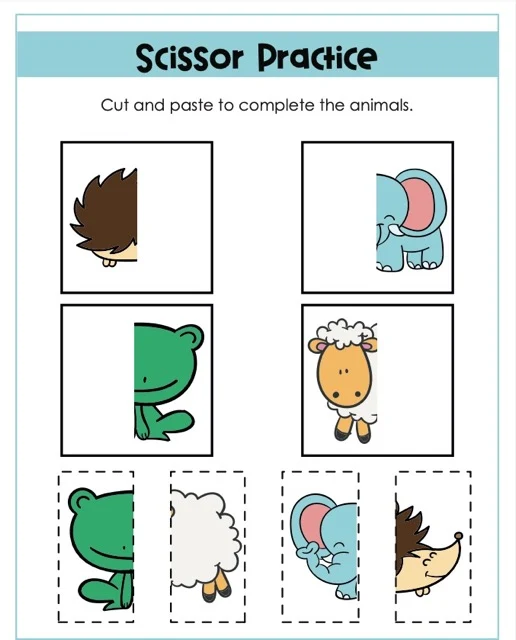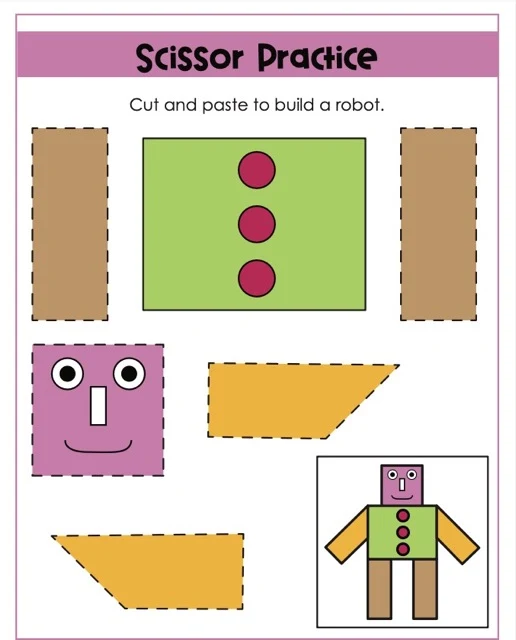Developing Scissor Skills in Children
Three sources explore the development of scissor skills in children. One offers a question-and-answer format covering skill development, milestones, activities, and safety. Another provides a study guide with key terms, a quiz, and essay questions for deeper learning. The third is a collection of visual worksheets designed for scissor practice. Together, they emphasize the importance of scissor skills for fine motor development, hand-eye coordination, and overall academic progress, offering guidance for parents and educators.
Developing Scissor Skills in Children
Briefing Document: Developing Scissor Skills in Children
Introduction: This briefing document synthesizes information from three sources focusing on the development of scissor skills in children. The sources include:
1.
"Developing Scissor Skills in Children": A FAQ-style document providing an overview of scissor skills, their importance, developmental milestones, activity suggestions, and safety precautions.
2.
"Scissor Skills Development Study Guide": A guide containing key terms, a quiz with answer key, and essay questions prompting deeper exploration of scissor skills development.
3.
"Testing Theme: Scissor Activities.pdf": A collection of visually engaging scissor practice worksheets for children, showcasing various activity types.
Key Themes and Findings:
1. Importance of Scissor Skills:
Scissor skills are fundamental to a child's development, extending far beyond the ability to simply cut paper. As the "Scissor Skills Development Study Guide" emphasizes, scissor skills are directly linked to:
●
Fine Motor Skills: Using scissors strengthens the small muscles in the hands and fingers crucial for tasks like writing, buttoning clothes, and manipulating objects.
●
Hand-Eye Coordination: Cutting requires the child to visually track the line while simultaneously controlling the scissors, refining this essential skill.
●
Visual Tracking: Following cutting lines strengthens visual tracking abilities necessary for reading, writing, and other academic tasks.
●
Bilateral Coordination: The coordinated use of both hands while cutting fosters bilateral coordination, vital for many daily activities.
2. Developmental Progression:
Children begin exploring scissors around 2-3 years old, but mastery develops gradually. "Developing Scissor Skills in Children" highlights these milestones:
●
3-4 Years: Basic cutting skills emerge, starting with snipping and progressing to straight lines.
●
6 Years: Most children can comfortably cut simple shapes.
The "Scissor Skills Development Study Guide" prompts further exploration of the progression through elementary school, where more complex cutting tasks and projects involving increased precision and dexterity are introduced.
3. Pre-Scissor Skills and Activities:
Before handing a child scissors, it's essential to build foundational skills. The "Scissor Skills Development Study Guide" lists examples of "pre-scissor activities":
●
Tearing Paper: Develops hand strength and bilateral coordination.
●
Using Tongs: Refines hand manipulation and coordination required for scissor control.
●
Manipulating Playdough: Strengthens hand muscles and enhances dexterity.
Once ready for scissors, starting with activities like snipping playdough and cutting straws ("Scissor Skills Development Study Guide") allows children to gain control and build hand strength before tackling more complex cuts. "Developing Scissor Skills in Children" expands on these beginner activities by suggesting:
●
Cutting straight, curved, and zigzag lines.
●
Cutting out basic shapes (circles, squares, triangles).
●
Matching shapes and cutting activities.
4. Engaging Scissor Practice:
Maintaining a child's engagement is key to successful skill development. "Developing Scissor Skills in Children" suggests:
●
Incorporate Themes and Interests: Use themes like animals, vehicles, or favorite characters to make activities more appealing. "For example, a child who loves animals could cut out animal shapes or create animal crafts using scissors," ("Scissor Skills Development Study Guide").
●
Use Colorful and Textured Materials: Experimenting with various paper types, felt, or foam sheets adds variety and sensory stimulation.
●
Turn it into a Game: Create cutting challenges or competitions to make practice more enjoyable.
●
Praise and Encourage Efforts: Positive reinforcement boosts confidence and motivation.
5. Safety Precautions:
The "Developing Scissor Skills in Children" resource emphasizes the critical importance of safety:
●
Always supervise young children when using scissors.
●
Use child-safe scissors designed for small hands.
●
Teach them how to hold and use scissors properly.
●
Establish clear rules about scissor safety.
●
Store scissors safely out of reach when not in use.
6. Signs a Child May Need Additional Support:
Both the "Developing Scissor Skills in Children" and the "Scissor Skills Development Study Guide" list potential signs that a child may benefit from additional support with scissor skills:
●
Difficulty holding scissors properly.
●
Struggling to open and close the blades.
●
Excessive fatigue or frustration when cutting.
●
Unable to follow lines or cut out shapes accurately.
If any of these signs are observed, consulting an occupational therapist or early childhood educator is recommended.
7. Variety of Scissor Activities:
The "Testing Theme: Scissor Activities.pdf" source provides visual examples of various scissor practice activities, reinforcing the importance of variety. These activities demonstrate how scissor skills can be integrated with other learning areas, such as:
●
Math: Cutting and pasting shapes to practice geometry concepts or cutting numbered lines in sequence.
●
Literacy: Cutting out letters or words for spelling practice or creating story characters through cutting and assembly.
●
Art: Creating collages, paper crafts, or decorations using various cutting techniques.
This variety helps maintain a child's motivation while promoting a broader skill set.
Conclusion:
Developing scissor skills is a critical aspect of early childhood development, impacting fine motor skills, hand-eye coordination, and other essential abilities. By understanding the developmental progression, implementing a variety of engaging activities, prioritizing safety, and recognizing the need for additional support when necessary, parents and educators can effectively foster the development of this crucial skill set.
Developing Scissor Skills in Children
Scissor Skills FAQs
1. What are scissor skills?
Scissor skills refer to the ability to use scissors effectively and safely. This includes the coordination of both hands to open, close, and manipulate scissors, as well as the ability to follow lines and cut out shapes.
2. Why are scissor skills important?
Developing scissor skills is crucial for a child's fine motor development and hand-eye coordination. It helps strengthen hand muscles, improve finger dexterity, and enhances visual tracking abilities. These skills are essential for various tasks such as writing, drawing, crafting, and self-care activities like dressing and eating.
3. When do children typically start developing scissor skills?
Children usually begin exploring scissors around the age of 2-3 years old. However, they start mastering basic cutting skills between 3 and 4 years old. By the age of 6, most children can cut simple shapes with relative ease.
4. What types of scissor activities are appropriate for beginners?
For beginners, it's best to start with simple activities like snipping playdough, cutting straws, or practicing straight lines on paper. Gradually introduce activities involving curved lines, zigzag lines, and basic shapes as their skills progress.
5. What are some examples of scissor activities for preschoolers?
The provided source offers numerous examples, including:
●
Cutting strips and lines: Straight, curved, zigzag
●
Cutting out basic shapes: Circles, squares, triangles
●
Matching shapes and cutting: Identifying and cutting out matching shapes
●
Simple crafts: Creating paper crafts, puppets, or masks involving cutting
●
Sequencing activities: Cutting and pasting images in a specific order
●
Coloring and cutting: Coloring images and then cutting them out
6. How can I make scissor practice fun and engaging for my child?
●
Incorporate themes and interests: Use themes like animals, vehicles, or favorite characters to make activities more appealing.
●
Use colorful and textured materials: Experiment with different types of paper, felt, or foam sheets to add variety.
●
Turn it into a game: Create challenges or competitions involving cutting to make it more enjoyable.
●
Praise and encourage their efforts: Positive reinforcement boosts their confidence and motivation.
7. What safety precautions should I take when my child is using scissors?
●
Always supervise young children while they are using scissors.
●
Use child-safe scissors designed for small hands.
●
Teach them how to hold and use scissors properly.
●
Establish clear rules about scissor safety.
●
Store scissors safely out of reach when not in use.
8. What are some signs that my child may need extra help with scissor skills?
●
Difficulty holding scissors properly.
●
Struggling to open and close the blades.
●
Excessive fatigue or frustration when cutting.
●
Unable to follow lines or cut out shapes accurately.
If you notice any of these signs, consult with an occupational therapist or early childhood educator for further guidance and support.
Scissor Skills Development Study Guide
Scissor Skills Development Study Guide
Key Terms Glossary:
●
Fine Motor Skills: Small, precise movements involving the muscles of the hands, fingers, and wrists.
●
Hand-Eye Coordination: The ability to synchronize visual information with hand movements.
●
Visual Tracking: The ability to follow a moving object or a line with the eyes.
●
Bilateral Coordination: The use of both hands together in a coordinated manner.
●
Dexterity: Skill and ease in using the hands and fingers.
●
Snipping: Making small cuts with scissors, often used as an introductory activity.
●
Pre-Scissor Skills: Activities that prepare children for scissor use, like tearing paper, using tongs, or manipulating playdough.
●
Adaptive Scissors: Specialized scissors designed for individuals with physical limitations.
●
Occupational Therapist: A healthcare professional who helps individuals improve their daily living skills, including fine motor skills.
Short-Answer Quiz:
1.
Explain why scissor skills are considered crucial for a child's overall development. (2-3 sentences)
2.
At what age range do children typically begin to demonstrate basic scissor proficiency? (1-2 sentences)
3.
List three pre-scissor activities that can help prepare a child for using scissors. (1-2 sentences)
4.
Describe two scissor activities appropriate for a child who is just starting to learn how to use scissors. (2-3 sentences)
5.
Beyond cutting straight lines, what other cutting skills should preschoolers be practicing? (2 sentences)
6.
How can themes and a child's interests be integrated into scissor skill practice? (2-3 sentences)
7.
What type of scissors are most suitable for young children? (1 sentence)
8.
List three important safety rules to teach children about using scissors. (3 sentences)
9.
What might indicate that a child needs additional support in developing scissor skills? (2-3 sentences)
10.
Who can provide professional guidance and support if a child is experiencing difficulties with scissor skills? (1-2 sentences)
Short-Answer Quiz Answer Key:
1.
Scissor skills are crucial because they strengthen fine motor skills, hand-eye coordination, and visual tracking abilities. These skills are essential for various tasks like writing, drawing, and self-care activities.
2.
Children usually start mastering basic cutting skills between 3 and 4 years old.
3.
Pre-scissor activities include tearing paper, using tongs to pick up objects, and manipulating playdough.
4.
Two appropriate scissor activities for beginners are snipping playdough and cutting straws. These activities help children learn to control the scissors and develop the hand strength needed for cutting.
5.
Preschoolers should practice cutting curved lines, zigzag lines, and simple shapes like circles, squares, and triangles.
6.
Themes and interests can make practice more appealing. For example, a child who loves animals could cut out animal shapes or create animal crafts using scissors.
7.
Child-safe scissors designed for small hands are most suitable for young children.
8.
Three safety rules are: always supervise young children while using scissors, teach them to hold and use scissors properly (pointing away from themselves and others), and store scissors safely out of reach when not in use.
9.
Signs a child may need extra help include difficulty holding scissors properly, struggling to open and close the blades, excessive fatigue or frustration while cutting, and an inability to follow lines or cut out shapes accurately.
10.
An occupational therapist or early childhood educator can provide professional guidance and support for scissor skill development.
Essay Questions:
1.
Discuss the progression of scissor skills development from early childhood through elementary school. What skills and complexities are introduced at different stages?
2.
Explain how scissor skills are interconnected with other developmental areas, such as cognitive development, language development, and social-emotional development. Provide examples to illustrate these connections.
3.
Analyze the importance of providing a variety of scissor activities for children. How does variety contribute to a child's motivation, skill development, and creativity?
4.
Evaluate the role of play-based learning in developing scissor skills. How can playful activities enhance a child's engagement and make learning more enjoyable?
5.
Discuss the importance of adult guidance and support in fostering scissor skills. How can parents, educators, and therapists effectively facilitate a child's learning and address any challenges that arise?

